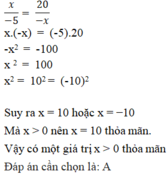

Hãy nhập câu hỏi của bạn vào đây, nếu là tài khoản VIP, bạn sẽ được ưu tiên trả lời.




Ể? \(x^2+x+1=0\Rightarrow\left(x+\frac{1}{2}\right)^2+\frac{3}{4}=0\left(VL\right)\) rồi mà SP.

Bài 1 :
a) x < 0
b) x > 0
c) <=> 3 + |3x - 1| = 5
<=> |3x - 1| = 5 - 3 = 2
<=> 3x - 1 = 2 hoặc -3x + 1 = 2
<=> 3 x = 3 hoặc -3x = 1
<=> x = 1 hoặc x = -1/3
Bài 2 :
a) 27 = 33 < 3n < 243 = 35
<=> 3 < n < 5
Vì n thuộc N* nên n thuộc {4; 5}
b) 32 = 25 < 2n < 128 = 27
<=> 5 < n < 7. Vì n thuộc N* nên n = 6
c) 125 = 5 . 25 = 5 . 52 < 5.5n < 5 . 125 = 5 . 53
<=> 2 < n < 3. Vì n thuộc N* nên n = 3

https://olm.vn/hoi-dap/detail/221248297106.html
tham khảo nhé
Áp dụng tính chất dãy tỉ số bằng nhau, ta có:
\(\frac{3}{a+b}=\frac{2}{b+c}=\frac{1}{c+a}=\frac{3+2+1}{a+b+b+c+c+a}=\frac{6}{2\left(a+b+c\right)}=\frac{3}{a+b+c}\)
\(\rightarrow a+b=a+b+c\) \(\rightarrow c=0\)
\(\Rightarrow P=\frac{3a+3b+2019c}{a+b-2020c}=\frac{3\left(a+b\right)+2019\cdot0}{a+b-2020\cdot0}=\frac{3\left(a+b\right)}{a+b}=3\)

a)\(\sqrt{x}=4\Leftrightarrow x=4^2\Leftrightarrow x=16\)
b)\(\sqrt{x-2}=3\Leftrightarrow x-2=3^2\Leftrightarrow x=9-2=7\)
c)\(\sqrt{\dfrac{x}{3}-\dfrac{7}{6}}=\dfrac{1}{6}\Leftrightarrow\dfrac{x}{3}-\dfrac{7}{6}=\dfrac{1}{36}\Leftrightarrow\dfrac{x}{3}=-\dfrac{41}{36}\Leftrightarrow x=-\dfrac{41}{12}\)
d)\(x^2=7vớix< 0\)
\(\Leftrightarrow\left(-x\right)^2=7\Leftrightarrow-x=\sqrt{7}\Leftrightarrow x=-\sqrt{7}\)
e)\(x^2-4=0với>0\)
\(\Leftrightarrow x^2=4\Leftrightarrow x=\sqrt{4}=2\)
f)\(\left(2x+7\sqrt{7}\right)^2=7\)
\(\Leftrightarrow4x^2+\sqrt{5488}+343=7\)
\(\Leftrightarrow4x^2+\sqrt{5488}=-336\)
\(\Leftrightarrow4x^2=28\left(12-\sqrt{7}\right)\Leftrightarrow x^2=\dfrac{28\left(12-\sqrt{7}\right)}{4}=7\left(12-\sqrt{7}\right)\)
\(\Leftrightarrow x=\sqrt{7\left(12-\sqrt{7}\right)}=\sqrt{84-7\sqrt{7}}\)

Áp dụng tính chất dãy tỉ số bằng nhau ta có:
b+c+d/a=c+d+a/b=d+a+b/c=a+b+c/d=3(a+b+c+d)/a+b+c+d=3
suy ra k=3
taco:\(\dfrac{b+c+d}{a}=\dfrac{c+d+a}{b}+\dfrac{d+a+b}{c}=\dfrac{a+b+c}{d}=k\)=>\(\dfrac{b+c+d}{a}+1=\dfrac{c+d+a}{b}+1=\dfrac{a+b+d}{c}+1=\dfrac{a+b+c}{d}+1=k+1\)=>\(\dfrac{a+b+c+d}{a}=\dfrac{a+b+c+d}{b}=\dfrac{a+b+c+d}{c}=\dfrac{a+b+c+d}{d}=k+1=\dfrac{a+b+c+d+a+b+c+d+a+b+c+d}{a+b+c+d}=\dfrac{4.\left(a+b+c+d\right)}{a+b+c+d}=4\)
=>k+1=4
=>k=3

a)\(\left(\frac{4}{5}\right)^{2x+7}=\left(\frac{4}{5}\right)^4\)
=> 2x + 7 = 4
2x = 4 - 7
2x = -3
x = -3 : 2
x = -1,5
Vậy x = -1,5